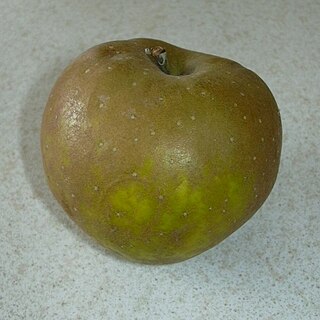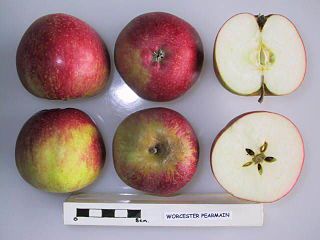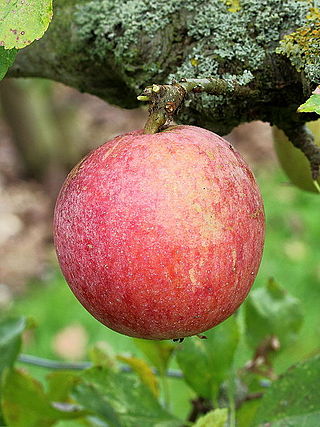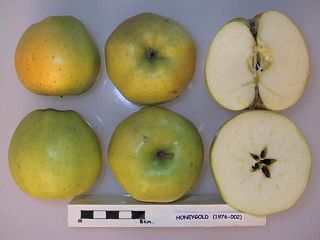Related Research Articles

Cox's Orange Pippin, in Britain often referred to simply as Cox, is an apple cultivar first grown in 1825 or 1830 at Colnbrook in Buckinghamshire, England, by the retired brewer and horticulturist Richard Cox.

A cooking apple or culinary apple is an apple that is used primarily for cooking, as opposed to a dessert apple, which is eaten raw. Cooking apples are generally larger, and can be tarter than dessert varieties. Some varieties have a firm flesh that does not break down much when cooked. Culinary varieties with a high acid content produce froth when cooked, which is desirable for some recipes. Britain grows a large range of apples specifically for cooking. Worldwide, dual-purpose varieties are more widely grown.

Gala is an apple cultivar with a sweet, mild flavour, a crisp but not hard texture, and a striped or mottled orange or reddish appearance. Originating from New Zealand in the 1930s, similar to most named apples, it is clonally propagated. In 2018, it surpassed Red Delicious as the apple cultivar with the highest production in the United States, according to the US Apple Association. It was the first time in over 50 years that any cultivar was produced more than Red Delicious.

Russet apples are varieties and cultivars of apples that regularly exhibit russeting, partial or complete coverage with rough patches of greenish-brown to yellowish-brown colour. While russeting is generally an undesirable trait in modern cultivars, russet varieties are often seen as more traditional, and associated with aromatic flavours.

The Elstar apple is an apple cultivar that was first developed in the Netherlands in Elst in the 1950s by crossing Golden Delicious and Ingrid Marie apples. It quickly became popular, especially in Europe and was first introduced to America in 1972. It remains popular in Continental Europe, but less so in the United Kingdom.

Jonathan is a medium-sized sweet apple, with a touch of acid and a tough but smooth skin, good for eating fresh and for cooking. Parentage = Esopus Spitzenburg x ?

Reinette, often Rennet in English, and popular in Italian and Portuguese cuisines as Renetta and Reineta respectively, is the name of a number of apple cultivars, in the Diel-Lucas and the Diel-Dochnahl apple classification system. Reinettes are divided into the following groups.

'Ribston Pippin' is a triploid cultivar of apples, also known by other names including 'Essex Pippin', 'Beautiful Pippin', 'Formosa', 'Glory of York', 'Ribstone', 'Rockhill's Russet', 'Travers', and 'Travers's Reinette'.

A pearmain, also formerly spelled "permain", is a type of apple. The name may once have been applied to a particular variety of apple that kept well, although in more modern times its inclusion in varietal names was, like the term 'Pippin', "largely decoration" rather than indicating any shared qualities.

'Adams Pearmain', also called 'Adam's Parmane', is a cultivar of apple. It was introduced to the Horticultural Society of London in 1826 by Robert Adams, under the name 'Norfolk Pippin'. The fruit is large, varying from two and a half inches to three inches high, and about the same in breadth at the widest part. It is pearmain-shaped, very even, and regularly formed. The skin is pale yellow tinged with green, and covered with delicate russet on the shaded side; but deep yellow tinged with red, and delicately streaked with livelier red on the side facing the sun. The flesh is reddish, crisp, juicy, rich, and sugary, with an agreeable and pleasantly perfumed flavor. This Cultivar is a sibling of Reinette de Hollande, a hybrid between Reinette Franche’ and ‘Reinette des Carmes. (5)

Anna apple is a dual purpose cultivar of domesticated apple that is very early ripening and does well in warm climates.

'Akane', also known as 'Tokyo Rose', 'Tohoku No.3' and 'Prime Red', is a Japanese cultivar of domesticated apple, that according to Orange Pippin is one of the best early season apples.

'Worcester Pearmain' is an early season English cultivar of domesticated apple, that was developed in Worcester, England, by a Mr. Hale of Swanpool in 1874. It was once the most popular cultivar in England for early autumn harvest and is still popular to keep in the garden. It has been extensively used in apple breeding.

'Allington Pippin' is an English cultivar of domesticated apple, with a strong flavour that includes hints of pineapple.

King of the Pippins or Reine des Reinettes (French), Goldparmäne, Wintergoldparmäne (German) is an old cultivar of domesticated apple originating from France, and is still used in its original form as well as in many derivative cultivars that have been bred from it. It was also formerly known as Golden Winter Pearmain, because of its ripening period at late fall.

Florina which is also called Querina, is a French cultivar of domesticated apple, that has combined traits of the Jonathan, Golden Delicious and Rome apples, and was developed in Angers, France, by the "Station de Recherches d'Arboriculture Fruitiere". Although developed in France its ancestry is entirely American.

Golden Russet is an old American cultivar of domesticated apple which is excellent for fresh eating as well as for apple cider production. It is a russet apple and is therefore especially used as a cider apple. It is sometimes known as 'English Golden Russet', and has frequently been confused with 'English Russet'.

Winston is an English cultivar of domesticated apple which was first named Winter King because of its availability in the winter, but was renamed as Winston in 1944 or in 1945, after Winston Churchill.

Reinette du Canada or Canada Reinette is an old cultivar of domesticated apple of unknown origin grown in Europe under various names and listed in France as a Canadian apple at least as early as 1771. It is a reinette type of golden apple, with much russeting, which keeps shape in cooking and is mainly used for that purpose especially in apple strudel.

'Honeygold' is a cold-hardy cultivar of domesticated apple, which was developed to suit for the northern cold areas. It was developed by the Minnesota Agricultural Experiment Station's Horticultural Research Center of the University of Minnesota. They were crossing a Golden Delicious with a Haralson in order to obtain a Golden Delicious style fruit with the cold hardiness of the Haralson, a goal which was successfully achieved.
References
- ↑ "Bulletin #7126, Wild Apple Trees for Wildlife - Cooperative Extension Publications - University of Maine Cooperative Extension". Cooperative Extension Publications. Retrieved 2024-09-25.